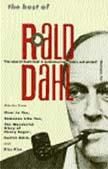
Most people are aware that Roald Dahl is one of the all-time great authors of children’s literature. His books include Charlie and the Chocolate Factory, James and the Giant Peach, The Witches, Danny the Champion of the World, The Twits, Matilda, and my personal favorite, The BFG. All of these books are required reading for young children. If your parents didn’t read them to you when you were a kid, it’s because they didn’t love you.Unfortunately, far too few people are aware that Roald Dahl was also a prolific writer of novels and short stories for adults. There are many fine collections of his stories available, but one of the most extensive is The Best of Roald Dahl.
Perhaps the Washington Post did the best job of describing his works when one reviewer wrote that “the mind of Roald Dahl is quintessentially nasty and wicked.” These stories are not for kids, yet one can tell that the author of these tales and the classic children’s books are one and the same. There’s a simultaneously comforting and unsettling justice present in Dahl’s stories. In both series, villains get their comeuppance and humor is plentiful.
In the children’s stories, the villains are larger than life. Be they muscle-bound, abusive headmistresses; a race of magical child-killers; spoiled brats; cannibalistic giants, or shape-shifting monsters from outer space; they all waltz into the story, create delicious mayhem, and receive poetic justice at the end.
In Dahl’s tales for adults, the bad guys are ordinary people with common but debilitating flaws. Compulsive gamblers, frauds, shysters, bullies, serial killers, self-righteous vegetarians, and a legion of common fornicators fill up the list of people who are ripe for punishment.
There are a few sub-par entries in this anthology. “Georgy Porgy,” a diatribe against sexually carnivorous women; “Madame Rosette,” the story of a brothel owner’s downfall, and “Edward the Conqueror,” a tale about a historical figure possibly reincarnated as a cat, all lack Dahl’s trademark of the exquisite surprise ending twist.
More often than not, though, Dahl produces a nearly flawless gem. One never really outgrows Dahl. People of all ages can appreciate the morals, plots, and humor of these stories. In fact, a lot of college students could probably stand to learn the lessons expressed in these tales.
Probably the most famous is “Lamb to the Slaughter,” the classic tale of a perfect murder and an ingenious disposal of the weapon. The heart of the story is a message of the pain that infidelity can generate.
The Edgar-winning “Skin” is the perfect story for parents to read to their children in order to dissuade them from getting a tattoo. “The Bookseller” lampoons the pornography industry without the tiniest trace of preachiness. People in relationships with domineering individuals would do well to read “The Way up to Heaven” to their significant others.
“The Visitor” is a highly suspenseful way to warn about the dangers of playing the field. “Genesis and Catastrophe: A True Story” is a disturbing reminder that every life holds the potential for great good-or evil.
I can’t even begin to explain the plots of these stories, for I’ll either spoil the endings or create a false impression about the message that Dahl is trying to convey, and that would do the great writer an injustice. Suffice it to say, these are all morality tales, but Dahl is one of the few writers of the genre who knows how to craft a compelling story that is not didactic.
Dahl is writing to entertain, but he also has the goal of teaching his audience right from wrong. Indeed, these stories tell us a lot about ourselves while still remaining pure, unadulterated fun.
Dahl’s characters are not being punished for their flaws. The author is far too sympathetic to the human condition for that. Dahl finds it unfair to condemn his characters for not being paragons of virtue. No one is perfect. It’s natural and healthy to look at oneself, identify one’s shortcomings, and attempt to do better.
What he cannot forgive is when sinners convince themselves that they have done no harm. Dahl loves to punish characters that lie, cheat, and steal, and somehow manage to convince themselves and others that they’re doing nothing wrong.
I’m moralizing here, but I don’t care. I’m trying to explain Dahl’s stories here, and I have to convey that Dahl has succeeded in the tricky task of making morality tales fun and suspenseful. These are more than light entertainment. They’re skillfully crafted sermons, and thrillers as well.
We may suppress our own feelings of guilt, but that does not obliterate the damage that our harmful actions cause. What is the price of a life spent in self-deception? For Dahl, the consequences range from private humiliation to grievous physical loss to a sticky and ironic death.
Personal satisfaction is nothing if it inflicts harm on others. If we know that something is destructive to ourselves and others, that thing is not worth the cheap pleasures that it brings. Dahl knew that, even if his own life didn’t always reflect that.
Fortunately, his stories almost always do. We can kick back, relax, and enjoy watching humans suffer for their crimes, content in the knowledge that this is just highly entertaining fiction.
It’s a lot of fun to read about a world where one can be assured of absolute, poetic justice. But we wouldn’t want to live in such a world. How long would any of us survive in a universe where Roald Dahl were the omnipotent judge, jury and executioner?
